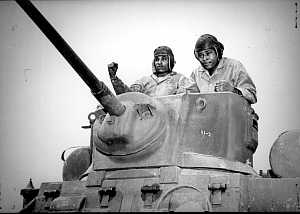
Copyright 2002 T. Sheil & A. Sheil All Rights Reserved

Frankly, I think that most fans of plastic army men over-rate the tank. It is a powerful machine on the modern battlefield, but it has its limitations. Tanks have a specific place in the order of battle. There are situations where the tank is overwhelmingly superior, and others where its advantages are offset and even negated. As with any weapon system,. there are situation where the tank is supreme, and situations where other systems have the upper hand. That is something any soldier learns if he is in the combat arms (Infantry, artillery, armor, combat engineering).
That being said, the tank remains the most popular accessory for plastic modern soldiers. No other vehicle can equal its appeal. We can have half-tracks, Jeeps, trucks, artillery, and even more modern personnel carriers and LVTs, but none will ever quite do it.
Tanks fascinated me, and still do. Would I want to serve in one? No way! A tank is the most uncomfortable armored vehicle ever made, then or now. I can tell you for a fact that being in a self-propelled howitzer is not comfortable at all, and working the gun only makes it worse. Personnel carriers are no prize, either. The M113 is not made for comfort, and Russians have told me that the BTR40 and BMP were no price, either. Add the fact that a tank is a big target and an inviting target. Its superior armor and its armament make it a conspicuous thing. A fellow working an antitank weapon like the TOW missile, given the choice between a tank, self-propelled gun, armored personnel carrier or truck will almost always go for the tanks first. Ditto for attack helicopter crewmen and other tank crews. No, thanks. If I had to do it again, I'd go back to Mechanized Infantry. The tank fascinates me, but not enough to want to man one.
I had done a lot of research into World War II tanks when I was in high school. Back then, I even had a card file with each tank's top speed, armor (top, bottom, front, sides, turret, etc), armaments and other particulars. Those things matter. Armor and armament is how a German Tiger 1 would be unfazed by a hit from a 75mm gun, but destroy almost any vehicle packing a 75. There are also matters of crew comfort, mechanical reliability, speed, fuel consumption. Crew comfort? Well, German crews would ram a Russian tank, knowing they would emerge without a scratch while the Russians would sustain injuries. A tank that is safer for the crew means higher survivability.
Did you know that during World War II, it was expected that a tank would break down every 35 miles it rode? This was a common guesstimate, especially in the German army. German tanks were known for mechanical and structural problems. They usually did well on the battle field. The problem was getting enough of them running so you could get them to the battlefield. Here's another one: burning fuel. Russian tanks well into the 1970s were known for how they burnt fuel. Suffice to say that camouflage them as you will, the telltale plume of smoke would give them up quickly.
Mechanical reliability is almost as important as ease of maintenance. US tanks have always been designed so a vehicle could be repaired easily, even to the point of replacing entire motors and swapping out parts. Russian and German tanks were not as well made. Or in the case of Germans, they were too well-made. Where Russia used too few parts in their designs, the Germans used too many. For instance, an American breech block on one gun had seven parts. Its German counterpart had 56. American gunners who saw the German one remarked that is was beautifully engineered, but its over-engineering was its weakness. Making all those precision parts took time, and if any one broke the breech was useless.
Most tanks had to stop moving in order to fie. There were a few that had gyroscope sights that allowed them to aim, fire and move all at once. However, most had to stop a moment to correct their aim and fire. The gyroscope thing was not practical for tanks with heavy turrets prior to 1980. Usually it was used in light or medium tanks, such as the Stuart and Sherman.
A tank has to be able to do three things: move, communicate and shoot. If it can move and shoot but not communicate, all you have is a loose cannon. If it can shoot and communicate, but not move, it is just a big pillbox. And if it can move and communicate but not shoot, all you have is a great big portable radio.
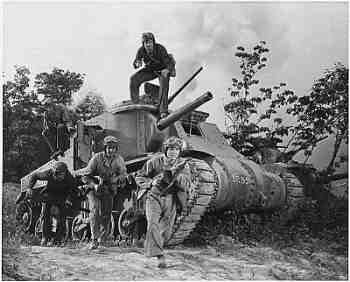
The crew of a tank is generally four to five men. These are:
Commander: he is the one who guides the tank, tells the crew where to go, what targets to shoot, etc.
Gunner: He aims the gun and fires.
Loader: the man who maintains and loads ammunition
Driver: the man who actually steers and drives the tank.
Radioman: in World War II era tanks, he was responsible for communications with the rest of his unit. He handled all communication with those outside the tank. The radioman has been made obsolete by technology. The commander also serves as radioman today.
Here are the essential parts of a tank:
Hull - the main body of the tank,
Glacis Plate - front of the tank, normally the most heavily armored part of the hull.
Turret: the rotating section that carries the gun
Bogies: unpowered road wheels
Idler: wheels that merely support track
Return roller: an idler at the end of the tank
Drive, or sprocket: geared wheel that actually grabs and moves the track on which the tank rides
Track: segmented plates on which the tank runs
Engine compartment - where the motor is housed.
Hatches: these are usually a Commander's Hatch and loader's hatch on the turret, a driver's hatch behind the glacis, and an escape hatch under the hull.
Gun Mounting: heavily-armored plate in which the gun is fitted.
Travel lock: a ring into which the gun muzzle is inserted and locked, for transporting the tank when not in combat.
Periscopes: these are used for looking when the crew operates with the hatches closed, curing combat.
Field Phone: a phone is normally houses at the rear of the tank, so infantry can communicate with the crew when the tank is used in an infantry-support role.
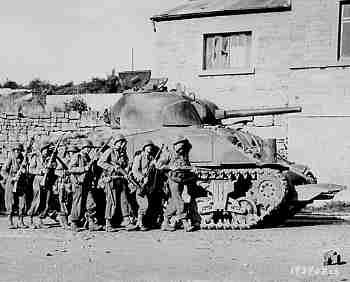
Tanks: where to hit, where not to aim
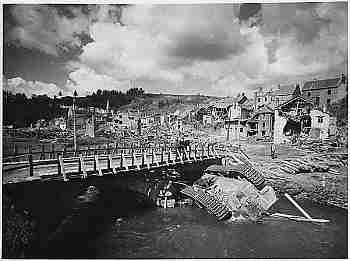
The tank is built according to a certain plan for efficiency. Having full armor on all surfaces would make it too heavy to move. Thus, armor is increased where it is most likely to be hit, and decreased in areas unlikely to be targeted. The heaviest armor is on the glacis plate and front of the turret. The turret sides, especially to the front, are also heavily armored. Weak points are the rear, the sides of the hull, the roof and the underside of the hull. Those using bazookas and other antitank weapons are taught to go for a side, rear or underbelly shot, if possible.
One very weak area is the tracks and wheels. Disabling these immobilizes a tank. It can still shoot, but it is a stationary target. Unable to move, it is more vulnerable to other kinds of attacks.
Frontal armor is thickened and sloped to block or deflect shots. The shot most likely to penetrate is one so that the target is perpendicular to the shot's impact. Sloping deflects shots that might otherwise penetrate.
One particularly nasty trick is to hot an armor with an explosive, so that it causes flaking. In the 1950s we had HEP - High Explosive Plastic, also known as "Squash-head ammo. It would flatten on the tank and explode, causing a concussion that flaked armor from inside. This shrapnel would bounce in the tank's interior, killing or maiming the crew.
HEAT - High Explosive Anti tank - is what bazookas and rockets use, as well as being a type of regular tank ammunition. It involves a shaped charge that explodes on impact. The charge literally burns and blows into the tank, making a little hole. It also causes shrapnel like flaking and it blows some of the explosion into the tank.
Armor Piercing ammo is hardened steel that has a high-velocity powder propelling it. Its speed and hardness penetrate the armor. Today, this is done by Sabot ammo. Sabot is a very hard spike packed in a sleeve. In effect, the spike is fired at the velocity of the 105mm shell. However, the sleeve falls off. The spike puts all the force of that velocity into a smaller area. More impact, smaller area means more likely to penetrate. Shrapnel caused by penetration is what disables the crew. The shell tearing through the tank usually damages a few other things on the way.
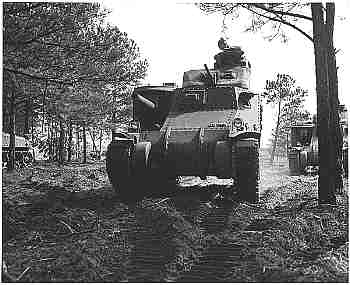
Forget the solitary tank you see in the movies. tanks work best in units. They move as a team. Their role is to break through, destroying as much of the enemy as they can along the way. The infantry follows up to finish the job.
Of course, tanks work best in open country. The reason some of the greatest tank battles happened in the desert (WWII, Middle East 1967 and 1973, Iraq in 1990) and open plains (Russia 1940 - 1945) is because they are natural "tank country". Wide expanses are best traversed in vehicles, and open ground allows vehicles more maneuverability. Tanks like to fight at long range. This maximizes the advantages of their armor protection, speed and heavy guns. Today's tanks are effective at extremely long ranges, too. Where the old 37mm guns of 1939 were good against armor at 500 to 750 yards (and remember, that was light armor), today's tank guns measure their range in miles.
Tanks work best in open and sparsely-wooded terrain. They are much less effective in built-up areas such as cities, heavily forested areas, and places with difficult terrain.
Tanks like to work with infantry support. The tank-infantry team is a unit of tanks supported by a unit of mechanized infantry. Tanks take care of the big stuff, while infantry wards off the weapons of the small stuff - mainly enemy infantry.
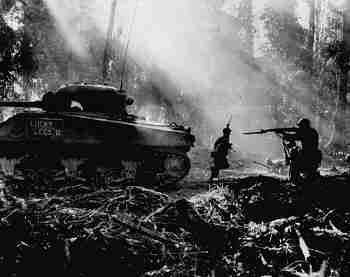
Armored units like to know what is ahead, so they use reconnaissance. Today, helicopter reconnaissance is part of armor doctrine, as is the use of lightly-armored or unarmored reconnaissance ground units. Most armored units have a recon section. In the US, most of these are cavalry units. They utilize fast personnel carrier and light tanks to go ahead, scout for the enemy, and retreat without having to fight. They have lighter weapons which they use to cover themselves as they retreat, should contact be made. Light recon units are not armed to slug it out. Their role is to "sneak, peek, and retreat."
Tanks do not like to be restricted in their movements. Mobility is one of their assets, and any restriction inhibits it. Movement in heavy forests, through bogs or swamps ,and in built-up areas impedes them and robs them of a key assert. Likewise, tanks like to work in the widest area possible. They avoid limitations on their ability to move across the land.
Built-up areas are especially dangerous, as they leave the tank open to ambush by infantry using explosives or antitank weapons. Infantry is trained that a tank in a restricted area is a better target. If caught on a narrow street, for instance, it is easier to attack a tank successfully. This is why tanks in unfavorable terrain always have infantry support.
Forget the movies: it is not easy for infantry to overcome tanks. The simplest tactic to use if infantry jump on a tank is to have another tank in the unit shoot them off with machine-gun fire. Since .30 caliber or 7.62mm bullets won't penetrate the friendly tank, it is easy for another tank to clear off the infantry. A tank may have limited visibility when its crew has the hatches closed, but it is not a sitting duck.
Likewise, jumping on a tank and throwing a grenade down the hatch is not easy. When crews close the hatches, they also lock them. Firing into vision slits is hard, since there are few such slits and many are blocked by thick glass or wire. What infantry usually does, if it catches a tank, is to destroy it with bazooka-type weapons or explosives. They first want to kill its mobility, which means ruining the track or suspension. Next they will place explosives in a place which is likely to cause spalling. They can pour gasoline into the engine compartment to set it afire or any number of tricks. First ,they have to catch a tank alone and vulnerable. Since tanks work in units and are supported by their own infantry, such scenarios are rare.
An infantryman's best options for handling enemy armor are:
Call for an air attack, either by jets or helicopter gunships.
Call in artillery
Call in his own army's tanks.
He only wants to use bazookas and the like as a last resort.
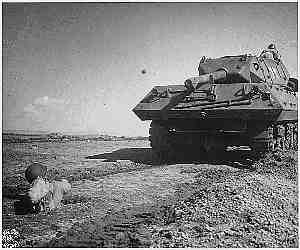
There are several kinds of tanks, each with their own specific roles.
Main battle tank, or medium tank: this is the main tank force, and involves tanks with the current medium armaments. It is capable of an average speed, not too fast, not too slow. It uses a combination of mobility and firepower to attack and defend. Examples include the M1 Abrams, M47, M48, M60, M26, M3 Lee / Grant, M4 Sherman, Centurion, Challenger, Cromwell, Chieftain, T34, T44, T54 / T55, T62, T72, Panzer 3, 4 and 5, Leopard, AMX 30, Merkava, Type 59.
Light tank: the light tank is a reconnaissance vehicle. It has less armor and firepower than medium or heavy tanks, but it has greater speed and mobility, Being smaller and lighter, it can get into places that larger tanks cannot, is less easy to detect, and is much faster. The light recon tank's role is to detect the enemy. It wants to avoid a fight if possible. The lighter armaments allow it to fire a few rounds so as to disengage quickly, should the enemy see it and start shooting. Examples include the M3 and M5 Stuart tanks, M24 Chaffee, M41 Walker Bulldog, M551 Sheridan, Cruiser class, Crusader, Panzer 1 and 2, Czech T38, Luchs, Char'D and PT76.
Heavy Tanks: you don't see many tanks made as heavy tanks, although today's modern medium tanks outweigh the heavy tanks of the 1950s. The heavy tank's role was to attack with extra impact. They carried greater firepower and heavier armor, this could hand out more damage and sustain little or none themselves. Heavy tanks were used in breakthroughs, attacks and assaults against heavily-defended positions. They were also better defensively than the medium and light tanks. Their biggest drawbacks were their lack of speed and their size. It was harder to conceal heavy tanks and harder to move them because many were too heavy for the existing roads and bridges. They were slow, which made them easier to hit and easier to out-run. America had pretty much given up on heavy tanks, developing the M103 in the 1950s as its last one. These remained in service well into the 1970s, being passed on the to Marines. Russia's T-10 was the last development of the JS series of heavy tanks. It was last made in the 1950s, and many were parcelled out to client states after the T-10 was removed from the Russian tank force in the 1970s. Heavy tanks include the T-26 / M-26 Pershing, M 103, Churchill, Tiger series of tanks, KV1, KV85, JS 1through 3, T10.
Assault Guns: these heavily-armored tanks were meant for use against fortifications and occasionally as tank-destroyers. Most had replaced the turret by having the gun in a relatively fixed mantle, able only to traverse a few degrees within the mantlet. A low superstructure and reinforced armored hull provided protection, as did having a lower profile. Most true assault guns were fitted with howitzers and artillery guns rather than antitank weapons. The common armor doctrine placed them with the artillery rather the armor. In actual fact, assault guns were often used in place of tanks or tank destroyers. Lack of a turret diminished their effectiveness in these roles. Anything impeding their movement made them much more vulnerable than any turretted tank.
The US Army used turreted assault guns in their true role. These included a Sherman M4A3E8, armed with a 105mm howitzer, and a Stuart armed similarly. Other assault guns included the Sturmgeschutz, Brummbarr, ISU 122 and ISU 152, and KV2
Tank destroyer: the tank destroyer is a light tank fitted with a heavy gun. It is used to ambush tanks, fighting a "sneak, peek, shoot and run" style. The tank destroyer was an economical thing, since they were cheaper to make than true tanks and allowed an otherwise smaller vehicle to pack more of a punch. Armor protection was usually given a back seat to speed. The true tank destroyer is a light tank fitted with a larger-than-average gun.
Some tank destroyers were built along the lines of assault guns. These turretless vehicles with guns having minimal traverse were generally given extra heavy armor in front. Lacking mobility, they were only effective in ambush,m and many were eventually transferred to the artillery for use as assault guns. The entire concept of tank destroyers started fading in the 1950s, the role to be taken over by other weapons systems. Examples include the M-10 and M36, Ontos, Jagdpanzer, jagdpanther, ISU 76, ISU 85, Su100, and SU 122
Engineering Tank: these are tanks fitted as combat engineering vehicles, giving full armor protection to enhance engineering in battle. They include various bridge layers and other obstacle-negating vehicles. One range of them were tanks fitted with devices to clear minefields by exploding the mines. Some also carried short howitzers for use against fortifications.
Recovery tank: tanks fitted to recover damaged tanks, much like an armored wrecker. Armored recovery tanks protect the crew, allowing them to bring a damaged tank back to the maintenance area.
Infantry tank: ore-World War II tank doctrine called for a range of slow-moving, heavily-armored tanks to work in support of the infantry. They were supposed to lead the infantry assault. They had heavy frontal armor and relatively light armaments. Their speed was slow, since they were meant to move at the pace of infantry. Few could reach 20 MPH. The infantry tank doctrine died quickly in the sands of North Africa and the fields of France. Infantry tanks were vulnerable to lighter, faster tanks and heavy antitank guns. Their slow speed made them easy to target, while preventing them from evading enemy gunnery. One infantry tank, the Churchill, evolved quickly to new roles as a heavy tank / assault gun for the duration of the war. Examples include the Matilda, Valentine and Churchill.

My personal favorites: as tanks go, it is natural to have some favorites. How they become favorites is a personal thing. In my case, they are the tanks I saw and knew. You might make your preferences on a tank's performance or history. It's subjective, so no one's picks will be the final word. Here's mine:
M48 - I have always liked the M48, since it was a tank that I grew up seeing. The M48's biggest asset is its longevity and adaptability. The current rendition is the M48A5, packing a 105mm gun. Yet look at the rounded turret and boat-shaped hull. It is definitely cool.
M41 Walker Bulldog - back in the late 50s, a toy tank came out that wowed us. The Walker Bulldog was a battery-operated tank that also fired plastic bullets. Needless to say, it was very popular. The M41 was also one of the first "Atomic Age" tanks touted by the Army as a new breed of technologically-superior weapons for the day. Like the Honest John rocket and the Atomic Cannon, the M41 Walker Bulldog was more than just a weapon system. It was...cool.
M47 - I have always liked the M47 because it was the image of a modern tank when I grew up. That was an American tank, plain and simple. The M47 has an interesting design, and believe it or not, many are in service today in third world countries.
Panzer 5 Panther - aesthetically, this design is a balance of angles and flat surfaces. The Panther is one of the best-looking tanks ever designed. Would you believe that its design also influenced most of the tanks developed between 1950 and 1970? It was a major influence on US, British and French tank design.
Char D'assault - the World War I French Tankette was a tiny little thing,but how could you not love its peculiar shape and quirky design?
M3 Lee medium tank: it did wonders in the North African desert, and it is one of the more peculiar designs. The Lee was an oddball, compared to other tanks, but it certainly made itself a place in history.
M3 Stuart Light Tank: in 1940 this was THE American tank. The Stuart is a boxy little thing that shows up everywhere. There was even one featured in a Tarzan movie in the late 60s or early 70s.
JSIII - this was perhaps the coolest of the Russian tanks, and it looks like Art Deco rather than the practical design of a Muscovite tank works. The last good-looking Russian tank.
Centurion MkIII - a very different tank, but a ubiquitous one. They were made by Matchbox and Lido, and we knew them as another green tank. Yet the Centurion has quite a history and is one of the most effective tanks ever made. Yeah - I like it.